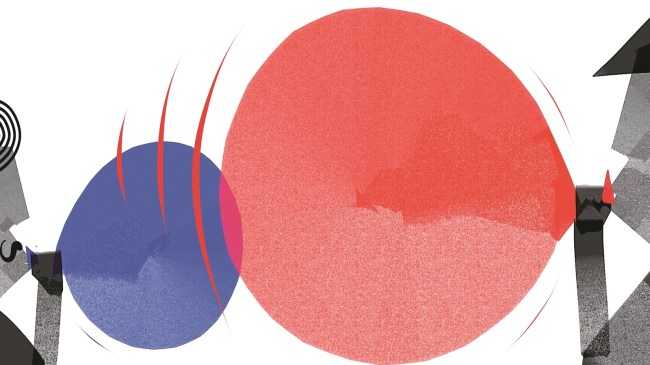Opinion Best of Both Sides: Reset with China is not a possibility
China remains India’s primary strategic challenge with very little convergence of interests
 China will have to do more to persuade India that its overtures are substantive. Comments in the Chinese media suggest deep scepticism about India’s China policy. (Illustration by C R Sasikumar)
China will have to do more to persuade India that its overtures are substantive. Comments in the Chinese media suggest deep scepticism about India’s China policy. (Illustration by C R Sasikumar) There is little doubt that the Donald Trump factor has complicated the geopolitical context in which India pursues its complex relations with China. Serious questions have surfaced about India’s strategic relationship with the US as Trump has underplayed Delhi’s geopolitical relevance and sent out negative signals on issues ranging from tariffs to Pakistan to sourcing of oil from Russia.
Compared to the first Trump term, when the US shifted to defining China as a “strategic competitor,” the second Trump administration’s strategy is far less coherent. The Chinese believe that they have stared down the US in their tussle on trade, tariff and export controls. Trump’s pursuit of a “beautiful deal” with China prioritises short-term economic gains over strategic clarity. The two countries are engaged in a serious dialogue, which could culminate in Trump’s visit to China later this year. Yet, China remains convinced that the US is seeking to slow down its rise.
In this environment, India and China are seeking more space with a relative thaw in their fraught relations. Yet, the India-China relationship has its own drivers and dynamics that will largely determine its future trajectory. Chinese Foreign Minister Wang Yi’s visit to India offers guarded optimism but no reset.
The Wang Yi visit produced a 10-point understanding, including resuming direct flights and reopening three border trade points. Steps have been taken to reboot discussions on border-related differences, along with progress towards rebuilding a damaged relationship, a process that commenced at PM Narendra Modi’s meeting with President Xi Jinping at Kazan in October last year. To what extent this two-track approach will yield substantive outcomes will depend largely on how serious China is about addressing India’s concerns. The evidence so far suggests a tactical outreach by China without accommodating India’s interests and sensitivities.
After Chinese transgressions in eastern Ladakh, the border issue has returned to the centre-stage. The business of disengagement is still unfinished as there are continuing restrictions on patrolling by Indian troops and the grazing activities of Indian herdsmen in areas they traditionally visited in “buffer zones”. The de-escalation process has not made much headway, but now the two sides have agreed to “discuss de-escalation, beginning with the principles and modalities thereof.”
While structural challenges in the relationship remain unresolved, some of the old concerns have acquired more ominous overtones. The most alarming development is the recent China-Pakistan battlefield collusion, vividly demonstrated during Operation Sindoor in May 2025. China’s support went well beyond diplomatic support and deployment of advanced weaponry provided by it. There was close operational support with credible reports about the provision of real-time intelligence, surveillance, and reconnaissance (ISR), integrating command-and-control systems and advisory inputs, creating an extended theatre with China’s involvement without its explicit military engagement. We do not know whether this matter was broached with Wang Yi.
China has started construction of a massive hydropower project, thrice the size of the largest hydropower project in the world (Three Gorges), without considering the interests of the lower riparian, India. This issue was raised forcefully by the Indian side without getting much satisfaction. In recent months, we have seen China denying supplies of rare-earth magnets, specialised fertilisers and tunnel boring machines, and Foxconn being asked to withdraw several hundred Chinese technicians from factories in India. This issue was also taken up with the Chinese FM, and while there might be some easing of supplies, the weaponisation of India’s dependencies on China will not change.
As the PM told Wang Yi, India seeks stable, predictable and constructive relations with China. However, this objective will have to be pursued in a realistic manner, without overlooking unpalatable facts in engagements with China. China will have to do more to persuade India that its overtures are substantive and not merely cosmetic. Comments in the Chinese media suggest deep scepticism about India’s China policy. The perceived softening of India’s stance is seen as a sign of weakness, stemming from turbulence in its relations with the US.
China sees its own pressure points here. Thus, Chinese readouts on Wang Yi’s meetings with the Minister of External Affairs and National Security Adviser cited them as giving assurances on Taiwan being part of China and on the “One-China Policy”. The Ministry of External Affairs was constrained to clarify that there was no change in India’s position. In another effort to exploit India’s predicament vis-à-vis the US, the Chinese readout on Wang Yi’s meeting with the Prime Minister claimed India joined China in opposing “unilateral bullying”, a barely disguised reference to America.
The bottom line is that the answer to India’s anxieties with the US does not lie in making common cause with China, which remains its primary strategic challenge with a serious deficit of convergent interests. Unless the facts on the ground change, the process of normalisation with China should be carefully calibrated and a reset in ties is not a realistic proposition at present. Expectations from the PM’s forthcoming visit to Tianjin, China should be moderated accordingly.
The author is a former ambassador of India to China




